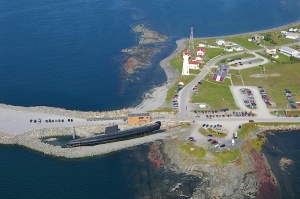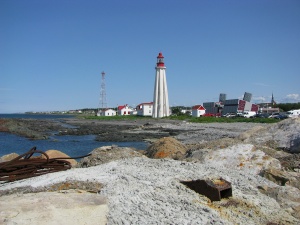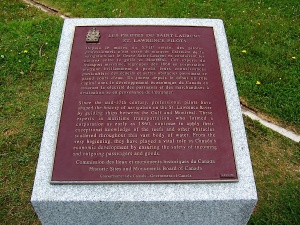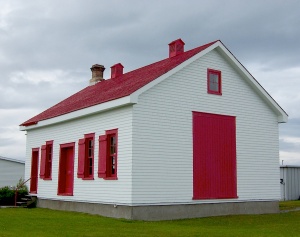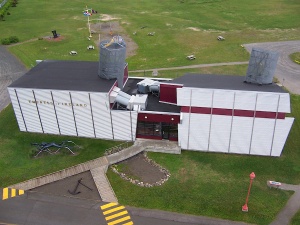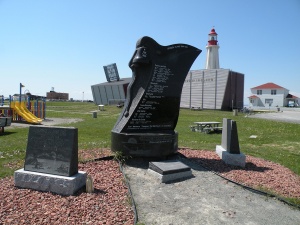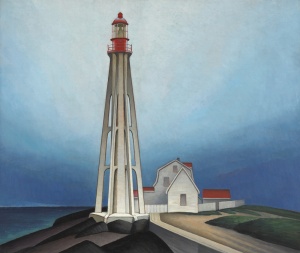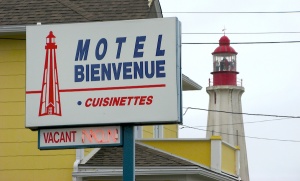Pointe-au-Père Navigational Aid Centre
par Violette, Brigitte
Designated a national historic site by the Government of Canada in 1974, the Pointe-au-Père Lighthouse, several kilometres east of Rimouski, was recognized “because of its historic role as an important pilotage service centre” and “because it was an important beacon for navigation on the gulf and river”. With this designation, the centre became a memorial site and it has continued to evolve over the 35 years of its existence, as various stakeholders have identified and developed a sense of ownership in it. A notable addition to the Pointe-au-Père Lighthouse was a museum, providing a venue for assembling and displaying in their original setting collections mainly associated with the maritime history of the Lower St. Lawrence and Quebec.
Article disponible en français : Station d’aide à la navigation de Pointe-au-Père
Point-au-Père’s Rich Heritage
For over a hundred years, the Point-au-Père site was one of the most important navigational aid centres in Canada. Its numerous buildings and the presence of a transfer station for St. Lawrence pilots meant that it was well-known to navigators. The principal chapters in the history of this navigational aid centre can be identified as: the construction, between 1859 and 1975, of four successive lighthouses, to which sound signals and various outbuildings were added; the operation of a pilotage station, between 1905 and 1959; the Marconi telegraph station, in operation from 1907 to 1959; the operation of a tidal and current survey station (1894-1985); and, the provision, from 1923 to 1937, of medical inspection services for ships entering the St. Lawrence. The centre also played a singular role in Quebec and Canadian maritime history in serving as the test site for various sound-generating systems prior to their being put into general use in other Canadian centres.
The Buildings Preserved
The buildings that have been preserved at the centre represent two major periods of modernization of Canada’s aids to navigation, one dating back to the beginning of the 20th century and the other to the 1970s. A vital symbol of the maritime heritage of the Lower St. Lawrence, the old reinforced concrete lighthouse, with its octagonal tower and eight buttresses, is unique both in its form and in the material used in its construction. This elegant structure, built to a design by French engineer, Louis Fernand Henri de Miffonis, is one of a series of nine lighthouses of its kind erected in various parts of Canada at the beginning of the 20th century, as part of a program to modernize the optical equipment in the country’s principal lighthouse stations. Constructed between 1906 and 1912, these lighthouses were designed by civil engineers in the federal Department of Oceans and Fisheries, working under the direction of chief engineer William P. Anderson.
In addition to the reinforced concrete lighthouse, the site includes a fog alarm building, a keeper’s house, an assistant keeper’s house (originally, the home of the sound signal engineer), a garage, a skeleton tower (the fourth lighthouse), a cistern, an electronic foghorn and two small pre-fabricated sheds. The site also encompasses many archaeological remains, most associated with the first two lighthouses and their outbuildings.
The presence of the Empress Pavilion, the Onondaga submarine and the visitors’ centre, all located near the historic site, can be attributed to the work of the Corporation du Site historique maritime de la Pointe-au-Père to enhance the site’s presentation of themes related to regional maritime heritage. The Pavilion houses an exhibition commemorating the tragedy of the sinking of the Empress of Ireland off the coast at Rimouski, on May 29, 1914, while the Onondaga invites visitors to discover the unfamiliar world of submarines.
Showcasing the Heritage of the Navigational Aid Centre
Federal Involvement
The presentation of the Pointe-au-Père Navigational Aid Centre as a piece of heritage began with the creation of the National Heritage Site by the federal government, acting on a recommendation from the Historic Sites and Monuments Board of Canada (HSMBC). This heritage designation was granted under a program launched in 1973 to commemorate navigational aid centres, through their most representative feature, their lighthouses.
The Point-au-Père Lighthouse first appeared in the “list […] of lighthouses of historical significance” in the minutes of the April 16, 1973 working session of the HSMBC; it was again referred to in “a few notes” contained in a report submitted to the 1974 spring meeting. The Board subsequently made a recommendation that the lighthouse “be recognized as having national historic significance and that a commemorative plaque be erected there”. The plaque was mounted several years later, in 1982 (NOTE 1). Since its designation, the Pointe-au-Père Lighthouse has been part of a network of national historic sites that commemorate, among other things, fifteen of Canada’s historical lighthouses, including those at Île Verte and Cap-des-Rosiers in Quebec.
In 1999, the Corporation des pilotes du Bas-Saint-Laurent requested that the HSMBC recognize as a national historic event the contribution of its members to the development of Canada. The Board issued a recommendation to this effect and proposed that a commemorative plaque be erected to highlight the critical work of pilots (NOTE 2).
While the HSMBC advises the federal government on its national historic commemoration program, which recognizes nationally significant sites, persons, events and other aspects of Canadian history, the Federal Heritage Building Review Office (FHBRO) deals exclusively with heritage buildings belonging to the federal government, which it evaluates principally from the perspective of their architectural value. In 1990, three buildings at the Pointe-au-Père Centre were submitted for FHBRO evaluation. Two were designated for their heritage value, namely, the light tower, which received the designation “classified”, and the fog alarm building, which received the designation “recognized”. The third building evaluated was the engineer’s house.
The light tower received the highest designation because of its very unique architecture as one of the few surviving examples of an octagonal, flying buttressed, reinforced concrete tower in Canada. The monument is also characterized by its bold, elegant profile which dominates, not only the light station itself, but also the surrounding area. The size and the simple form of the fog alarm building, and the fact that much of the original construction material and original equipment remains intact, make it an excellent example of this type of building, which served as a vital navigational aid.
Regional Involvement
The residents of the Lower St. Lawrence region consider the Point-au-Père Lighthouse to be one of the main testaments to their maritime heritage, perhaps even the symbol of it. A Rimouski street was named for it (rue du Phare), as was one of its schools (École du Vieux-Phare, now one of the two buildings that make up École Rose-des-Vents). The image of the Point-au-Père Lighthouse is used as for promotional purposes; it can be seen, for example, on the web site of Tourisme Rimouski, the organization responsible for the development of regional tourism for business and pleasure. The lighthouse (phare) also appears in several business names, such as the Restaurant du Phare, the Cabines du Phare or the Poissonerie du Phare Ouest, to say nothing of the inspiration it has provided and continues to provide to a large number of artists.
Not only the lighthouse, but the Pointe-au-Père site itself serves to commemorate the history of navigation in Canada and in North America, as highlighted by two monuments erected at the end of the 20th century. The first, unveiled in 1995, honours the memory of Royal Canadian Navy and Canadian Merchant Navy sailors from the Lower St. Lawrence, Gaspé and Magdalen Islands regions who died at sea during the Second World War (NOTE 3), as similar war memorials do in other parts of the country. Not far from this memorial, Le Gardien des altitudes has stood since 2000 to mark the importance of Point-au-Père as an elevation reference point in the establishment and monitoring of major elevation references in Canada, the United States and North America (NOTE 4).
Led by several lighthouse administrators and Québec Maritime, an organization dedicated to promoting tourism in the Lower St. Lawrence, Gaspé, Côte Nord and Magdalen Islands regions, numerous stakeholders joined together to develop and market “a Lighthouse Trail, an easily exported tourist product which would benefit everyone showcasing this unique maritime heritage” [Translation] (NOTE 5). As a member of the Corporation des gestionnaires de phares de l’estuaire et du golfe du Saint-Laurent, formed as a result of this initiative, the Point-au-Père Lighthouse is part of a heritage tour composed of a network of some 43 lighthouses along the coast or on one of the islands of maritime Quebec. In the case of twenty or so of them, either the tower itself or one of the outbuildings has been transformed into a museum or an inn.
Local Involvement
Initially, the Musée de la mer was located at the Institut maritime du Québec in Rimouski, opening on May 29, 1980 to mark the 66th anniversary of the sinking of the ocean liner, the Empress of Ireland. The museum’s main exhibits were artefacts recovered from the ship by a group of divers, including the collection of Philippe Beaudry, who made more than 600 visits to the shipwreck.
In 1982, the Musée moved to the Pointe-au-Père Lighthouse National Historic Site, near the wreck of the Empress. Since that time, through a working agreement with Parks Canada, this non-profit organization has been responsible for visitor services and for interpretative activities at the site. Over the years, the museum has expanded its collections and, in 2000, it opened an interpretive centre devoted to the sinking of the Empress of Ireland. At that time, the name was changed to Site historique maritime de la Pointe-au-Père, to reflect the shift in its activities. Today, its principal goals are to present the history of the Empress; to protect and display the Onondaga, a decommissioned Canadian Navy submarine, built in the sixties; and to work with other museums to showcase the maritime history of the region and of Quebec.
Heritage Presentations with Multiple Meanings
First identified under the federal commemoration program, the heritage value associated with the Pointe-au-Père navigational aid centre has evolved as the community and various corporate stakeholders have developed a sense of ownership in the site. Several layers of meaning have been added to the site over time. What, then, is the overall message conveyed by all the heritage presentations currently available at Pointe-au-Père?
Initially, the goal of the evaluation of lighthouse stations that led to the 1974 designation of the centre was to preserve representative examples of lighthouses for their historical and architectural value. The later HSMBC recommendations on commemoration (November 1976) and on the physical boundaries of the historic site (November 2005) meant that most of the elements of the navigational aid centre, including those which were only remains, were incorporated into the historic site.
The HSMBC and FHBRO designations were granted within a wider framework of all navigational aid centres established across Canada. In this sense, the historical value of the Pointe-au-Père centre cannot be fully understood without consideration of the larger Canadian network to which it belongs. In terms of Quebec maritime heritage, the Pointe-au-Père Lighthouse is one of a series of lighthouses built to guide navigation along the river and in the Gulf of St. Lawrence. This is why it is linked to its neighbours through the “Lighthouse Trail”, and the primary purpose of the Site historique maritime de la Pointe-au-Père is to present the maritime history of the Lower St. Lawrence region.
The monuments erected near the site are the result of a similar process of appropriating heritage, one which confirms and strengthens the role of the site as a place of remembrance. The memorial to the sailors of the Royal Canadian Navy and the Canadian Merchant Navy, for example, was erected to commemorate a specific aspect of Canadian history not necessarily linked to the past of this particular navigational aid centre.
The Pointe-au-Père site is an excellent illustration of the importance of taking into account recent scholarship in the presentation of a heritage asset. Initially designated as a symbol of maritime history in the 20th century, the lighthouse was later recognized for its considerable architectural interest (NOTE 6). More recently, previously unknown details on the designer of the reinforced concrete tower and on the context in which it was built have come to light and this has led to a new understanding of this symbol of the navigational aid centre. Historical research and further examination of the features of the lighthouse have also shed light on the influence of French civil engineering in Canada at the beginning of the 20th century, when the use of reinforced concrete was still at the experimental stage. Architect Léic Godbout, co-author of a work marking the one hundredth anniversary of the construction of the lighthouse, states that Miffonis not only used material that was innovative at the time, but he was also able to express modernity in an otherwise very prosaic architectural context. Through its bold form, his tower makes spectacular use of many of the qualities of this material and the expressive potential of the forms it made possible. The structure’s harmony and originality, as well as its power to evoke modernity, were captured magnificently in 1930, by the famous Canadian painter and member of the Group of Seven, Lawren S. Harris.
Pointe-au-Père Lighthouse Centre, a Site Worth a Return Visit
The various heritage presentations and the museum activities that have been developed at Pointe-au-Père have resulted in an increasing number of historical themes and messages to be shared with visitors. This illustrates the incredibly evocative power of the cultural resources that have been preserved, as well as the growth of a sense of ownership in the site among various groups in the Lower St. Lawrence region, in Quebec, in Canada, and even across North America. Now a part of the collective memory, the possibilities offered by the Point-au-Père navigational aid centre are both rich and diverse. Visitors interested in learning about and understanding the various aspects of the history portrayed by the region and the site will want to visit more than once.
Brigitte Violette, Historian
Parks Canada, Quebec Service Centre
Additional DocumentsSome documents require an additional plugin to be consulted
Images
-
 La maison de l’assist
La maison de l’assist
ant gardien -
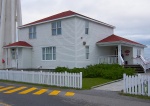 La maison du gardien
La maison du gardien
-
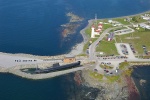 La station d’aide à l
La station d’aide à l
a navigation de... -
 Le bâtiment du criard
Le bâtiment du criard
de brume
-
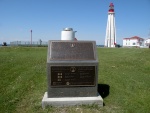 Le monument commémora
Le monument commémora
tif «Le gardien... -
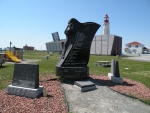 Le monument commémora
Le monument commémora
tif aux marins -
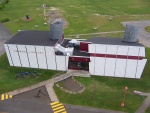 Le pavillon Empress
Le pavillon Empress
-
 Le phare de béton arm
Le phare de béton arm
é
-
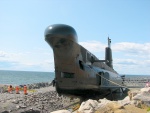 Le sous-marin NCSM On
Le sous-marin NCSM On
ondaga -
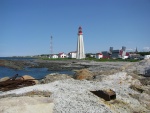 Les bâtiments de la s
Les bâtiments de la s
tation d’aide à... -
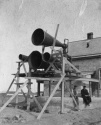 Les trompettes d’expé
Les trompettes d’expé
rimentation, 19... -
 Lighthouse, Father Po
Lighthouse, Father Po
int, 1930
-
 Lighthouse, Father Po
Lighthouse, Father Po
int, 1930 -
 Louis Fernand Henri d
Louis Fernand Henri d
e Miffonis, Ott... -
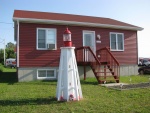 Maquette du phare de
Maquette du phare de
Pointe-au-Père ... -
 Maquette du phare de
Maquette du phare de
Pointe-au-Père ...
-
 Motel Bienvenue de Po
Motel Bienvenue de Po
inte-au-Père -
 Plan de phare en béto
Plan de phare en béto
n armé conçu pa... -
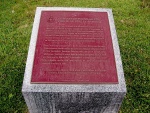 Plaque commémorative
Plaque commémorative
de la Commissio... -
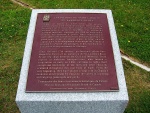 Plaque commémorative
Plaque commémorative
de la Commissio...
Hyperliens
Catégories
Notes
1. Parks Canada, “Excerpts of Historic Sites and Monuments Board of Canada minutes and plaque texts”, Commemorative Integrity Statement for the Pointe-au-Père National Historic Site, Parks Canada, Gaspé Field Unit, May 19, 2006, Appendix 1, pp. 26-30 [1]
2. The reason for the favourable recommendation was: “Pilotage by members of an organized profession has been part of navigation on the St. Lawrence River for over 350 years and is closely linked to Canada’s economic development and prosperity because it ensured the safe passage of transatlantic ships transporting passengers and manufactured goods to and from other countries” [Translation] (ibid., p.31).
3. This memorial was erected by Filial no. 36 (Joseph Keable, VC, MM) of the Royal Canadian Legion and the Fondation pour le cénotaphe des marins décédés. Maurice Harvey, a sculptor from Saint-Jean-Port-Joli, did the carving in the granite.
4. This commemoration was the initiative of the Canadian Hydrographic Association, with the support of the federal Department of Natural Resources and Department of Oceans and Fisheries, the Quebec Ministry of Natural Resources, the Université Laval and the National Oceanic Administration of the American Department of Commerce.
5. Corporation des gestionnaires de phares de l’estuaire et du golfe Saint-Laurent, La route des phares du Québec [on line], http://www.routedesphares.qc.ca/fr/lacorp.html, consulted July 2011.
6. In 1976, the HSMBC identified the reason for commemoration simply as the fact that “the building [the 1909 light tower] itself, while of relatively recent construction, must be preserved as the tangible symbol of the site’s importance”. [Translation] Sixteen years later, the FHBRO based its decision on further information and granted the highest designation to this structure because of “its strong architectural importance and its exceptional environmental value”.
Bibliographie
Fortin, Jean-Charles, « La grande navigation et les installations de Pointe-au-Père », Revue d’histoire du Bas-Saint-Laurent, vol. VIII, no 3, octobre-décembre 1982, p. 53-92.
Fortin, Jean-Charles, Histoire du Bas-Saint-Laurent, Québec, Institut québécois de recherche sur la culture, 1993, 860 p.
Larocque, Paul (dir.), Rimouski depuis ses origines, Rimouski, Société d’histoire du Bas-Saint-Laurent, 2006, 411 p.
Leclerc, Jean, Les pilotes du Saint-Laurent, 1762-1960 : l’organisation du pilotage en aval du havre de Québec, préf. de Pierre Camu, Sainte-Foy (Qc), Éditions GID, 2004, 855 p.
Lemieux, Paul, « Les installations maritimes de Pointe-au-Père en 1910 », Revue d’histoire du Bas-Saint-Laurent, vol. IX, no 3, octobre-décembre 1983, p. 74-79.
Parcs Canada, Énoncé d’intégrité commémorative du l.h.n.c. du Phare-de-Pointe-au-Père, Parcs Canada, Unité de gestion de la Gaspésie, 19 mai 2006, 41 p.
Violette, Brigitte, et Léïc Godbout, La station d'aide à la navigation de Pointe-au-Père et son phare de béton armé : centenaire d'une construction audacieuse, 1909-2009, Québec, Parcs Canada, 2009, 91 p.

